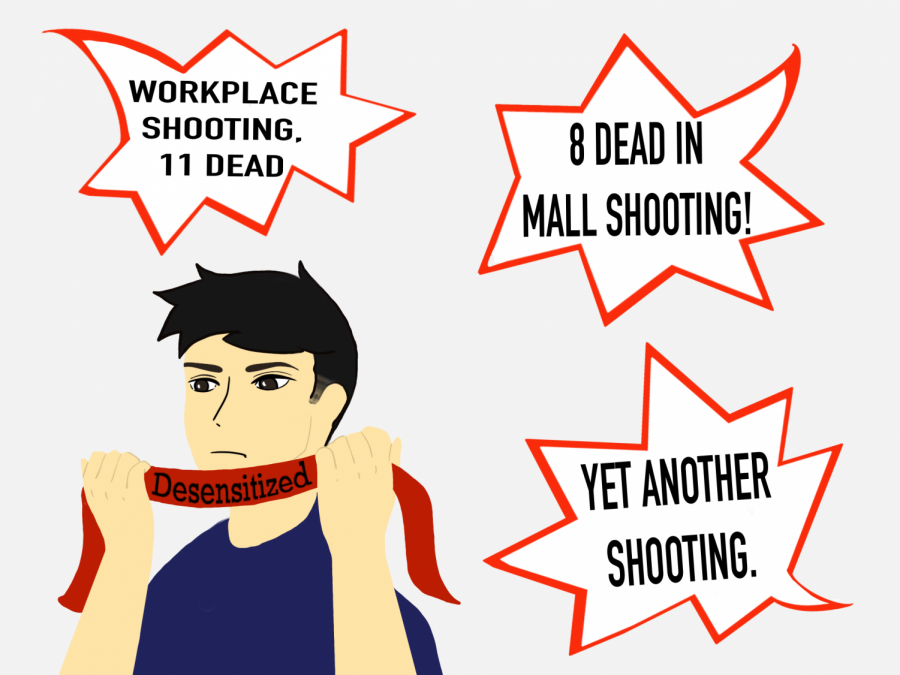Mass Shootings Are Our New Normal — And They Shouldn’t Be
June 3, 2021
In 2020, there were 614 mass shootings in the United States that fit the definition. The predicted number of mass shootings for 2021 is 511, according to Forbes.com. These high numbers show not only a history of violence, but also a future of continuing complacency.
America’s current gun laws allow a lot of leeway with background checks and do not provide lots of necessary restrictions that will keep our country safer. Extensive background checks are not enforced, and there are several ways for minors and unregistered gun owners to purchase firearms. Comparing America’s gun laws with a country that has, on average, around 10 shootings a year, shows the clear differences in the approach to controlling this dangerous issue. Back in the mid-1900s, any ownership of firearms was prohibited in Japan, and while that law has become looser, the initial starting point of complete prohibition shows the first major difference between gun laws in the U.S. and Japan. The law has been loosened, but with strict regulations including an all-day class, a written test, a mental health examination, an extensive government background check and a shooting-range test in which a person must pass with a 95% accuracy rate. All of this has to be done before purchasing a gun; only shotguns and air rifles are available for purchase, and some of these tests have to be retaken every three years. Gun stores are limited within Japanese districts, with strict rules that prioritize safety and trust. All of these rules and regulations accumulate into a much safer society where guns are rarely drawn. The differences between these two countries with their approach to gun control is shocking.
Question that many people ask are, “Why hasn’t the U.S. changed their gun laws? Violence by guns is only increasing, shouldn’t the government recognize this and at least tighten the restrictions?” These are questions I have asked myself many times. The people have not been silent. On March 24, 2018, I, and hundreds of others, took the streets of Washington D.C. to participate in the March For Our Lives. After the tragic school shooting at Marjory Stoneman Douglas High School, a group of students came together to create a movement that was demanding change. Several celebrities joined the rally including Ariana Grande, Miley Cyrus, Common and Andra Day. This was a major event that got people listening and viewing these students as equals with comprehensive thoughts and ideas. With every step, I felt like change was coming, yet here we are, five months into the new year, and the numbers are proving different.
Stereotypes about the U.S. and their love for guns proves to be true through the intense gun culture that plays a major role in the desensitization to mass shootings. Many households across the country do own one or more firearms. Hunting is considered a sport by many people. Shooting ranges are seen as a fun bonding activity for some families. These are just some aspects of gun culture that create this complacency towards guns overall. Guns in media and entertainment, especially Western films, are portrayed as these symbols of power and authority and are shown to be desired and wanted. People who have lost loved ones due to shootings, or those that have been involved in a shooting do not see guns as these prized possessions; they see them as objects of violence and pain.
Mass shootings will pop up on the news and the conditioned response has been to acknowledge the tragedy but then move on. How many times can this happen before these incidents stop being viewed? We as a society are so used to guns and shootings that it has become a stereotype for the country. Throughout social media, there are comments that say that in other countries, “at least they can go to school without fearing for their lives.” Lockdown drills are a common procedure in schools across the country, and while it is important to practice safety procedures, kids should not be waiting for the day someone comes running into their school with a gun. Big, publicized events such as the Pulse shootings or Columbine spark a wave of protest and unrest, but then it goes away, until the next big shooting happens and the cycle restarts. These shootings are becoming everyday rituals that we have to stomach and move on from. We need to go back and take a second look — what could have been changed? This future of complacency is putting everyone in danger.




Jeff Based • Oct 4, 2021 at 12:42 pm
Gun control isn’t needed, what we need is to give students firearms and armored vehicles
Mass shootings wouldn’t happen if every student had a gun tbh